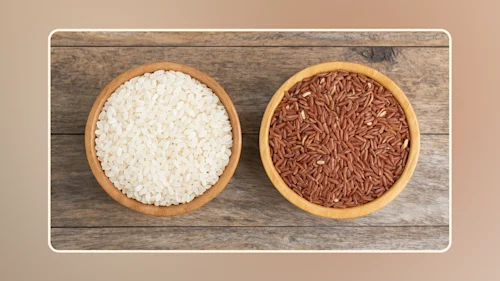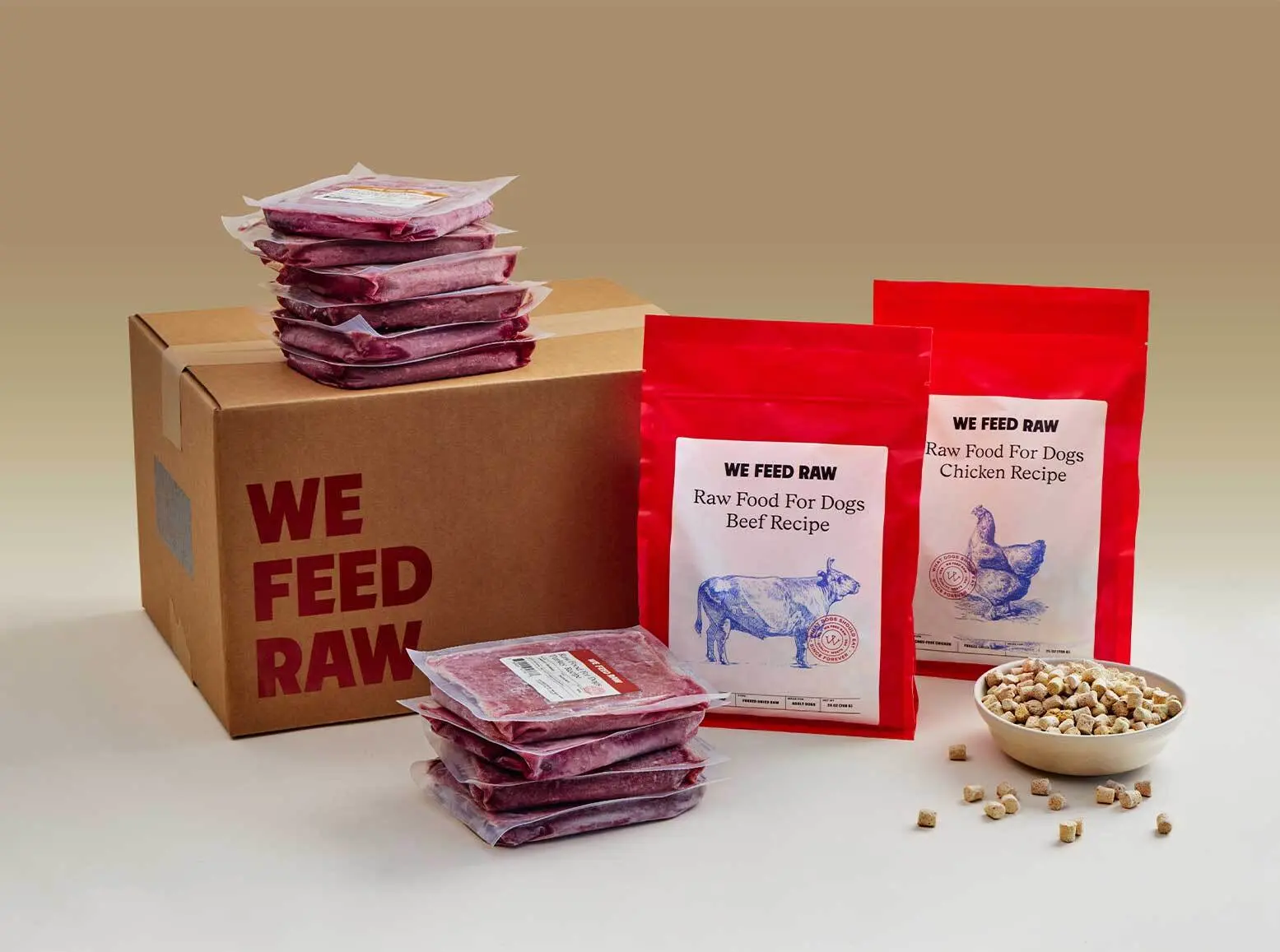
Brown Rice vs. White Rice for Dogs: Which One Is Better?
Table of Contents
Rice, a staple in many human diets, is also a common ingredient in commercial dog foods and is frequently recommended for its digestibility and soothing effects on the stomach. However, not all rice is created equally, and more importantly, it's vital to understand that dogs do not have a nutritional requirement for carbohydrates like rice in their diet.
At We Feed Raw, we're here to help you assess the role of brown rice vs. white rice for dogs. While it can be acceptable as part of a balanced diet, especially in specific scenarios, we'll explain why a truly ancestral frozen or freeze-dried raw diet offers your pup the most complete, balanced, and naturally carb-free meal for optimal health.
Can Dogs Safely Eat Rice?
Yes, dogs can safely eat plain, cooked rice in moderation. Rice is a common component found in many commercial dog foods, and veterinarians sometimes recommend it as part of a bland diet for dogs with temporary digestive issues.
While rice can provide calories, it shouldn't be relied upon as a primary source of nutrition, especially given that dogs have no biological need for carbohydrates. Let's walk through some of the considerations for incorporating rice into your pup’s diet, and when it might not be the best option for them.
When Rice Is Not Safe
While rice is generally safe for dogs, there are certain situations where it may not be the best choice. Dogs with grain allergies or sensitivities may experience symptoms such as digestive upset, itching, ear infections, or skin irritation after eating rice. If you notice your dog showing any of these signs, you should stop feeding them rice and consult with a veterinary professional.
Additionally, rice should always be served fully cooked and without any added seasonings, butter, garlic, or salt. We strongly recommend against feeding your pup uncooked rice, as it can lead to numerous gastrointestinal (GI) problems.
Overfeeding your dog rice in large quantities or too frequently can also contribute to nutritional imbalances, as rice lacks essential proteins, fats, and other vitamins dogs need to thrive, highlighting that dogs do not require carbohydrates to meet their nutritional needs.
Brown Rice
Brown rice is often touted as a "healthier" grain option due to its minimal processing. It's a whole grain that retains its outer layers (bran and germ), which makes it a richer source of fiber, certain B vitamins, and minerals compared to white rice.
While brown rice is nutrient-dense for a grain, it's important to remember that a dog's optimal diet doesn't necessitate grains at all. People considering adding brown rice to their dog's meals might be looking to boost the overall quality of their pup’s diet, especially if they are feeding kibble or a homemade diet that might otherwise lack fiber.
Benefits of Brown Rice
Feeding your dog brown rice can provide some health benefits, though these can also be easily obtained from a species-appropriate, carb-free raw diet. Brown rice contains B vitamins, which support metabolism, and minerals like magnesium for muscle function and selenium for thyroid health and antioxidant protection.
Additionally, brown rice has a lower glycemic index and more fiber than white rice. The presence of fiber can help your dog feel fuller and may aid in alleviating constipation. Because low glycemic foods can help with managing body weight and blood sugar, brown rice can contribute to minimizing the risk of conditions like type 2 diabetes and heart disease when fed in appropriate, small quantities as part of an otherwise balanced diet.
White Rice
White rice is a simple, familiar ingredient that many pet owners turn to when their dogs need a gentle, easy-to-digest meal. Its soft texture and simple composition make it a common choice for pups who are recovering from illness, dealing with an upset stomach, or experiencing temporary digestive issues.
Often recommended by veterinarians as part of a bland diet, white rice provides a source of quick energy and is designed to give your dog’s digestive system a much-needed break. While it has specific benefits that make it a valuable short-term option, remember that it’s not a nutritional necessity for dogs.
Benefits of White Rice
White rice can be a beneficial short-term addition to your dog’s diet, particularly when digestive support is needed. One of its key advantages is that it’s easy to digest, making it an ideal choice for pups with upset stomachs or those recovering from illnesses.
It is commonly recommended as a home remedy for dogs suffering from diarrhea due to its soluble fiber and higher starch content. This helps the rice absorb excess water in the intestines, binding loose stool and promoting firmer bowel movements. It also gives the gut a chance to rest while still supplying calories and energy.
However, it's worth noting that vets sometimes recommend pumpkin and turkey as even better alternatives for treating diarrhea than the traditional boiled chicken and rice. You can read more about this in our guide: What to Feed a Dog With Diarrhea.
White Rice for Weight Gain
In addition to its soothing properties, white rice is also a source of quick energy that can aid in healthy weight gain for underweight dogs. When paired with a high-quality protein like plain chicken or lean beef, white rice can help increase overall calorie consumption and support muscle maintenance.
If your pup doesn’t need to gain weight, it’s best to monitor the quantity of white rice you give them to prevent a rapid rise in their blood sugar levels.
Brown Rice vs. White Rice
Although brown rice and white rice are similar in their caloric contribution, they serve different purposes in specific scenarios depending on your pup’s needs. Generally speaking, brown rice offers more fiber, vitamins, and minerals, while also potentially supporting healthy digestion and promoting regular bowel movements.
White rice, on the other hand, is less nutritionally dense but is celebrated for being easier to digest, making it a common choice for dogs with sensitive stomachs or those recovering from an illness.
Ultimately, the choice between brown and white rice depends on your pup’s current digestive tolerance and dietary goals, but neither is a required component of a canine diet.
Beyond Rice: What Dogs Really Need
While many pet parents consider adding rice to homemade diets, believing it to be a healthier alternative to kibble (which it certainly can be, when done correctly), it's important to understand a dog's true nutritional requirements. Dogs are facultative carnivores, meaning their bodies are optimized for a diet rich in animal protein and fat, with very minimal carbohydrates. They do not require rice or any other grain to thrive.
An ancestral raw diet is formulated to meet these precise needs, eliminating unnecessary carbohydrates and fillers. This emphasis on bioavailable animal protein, healthy fats, and a carefully balanced blend of vitamins and minerals is what truly promotes peak health, energy, and longevity in dogs.
For those looking to provide superior nutrition without going fully raw immediately, We Feed Raw offers convenient freeze-dried raw beef and chicken recipes for adult dogs that make an excellent, carb-free kibble topper, boosting the protein and nutrient content of any meal.
Take the Ancestral Approach to Your Dog’s Diet: Choose We Feed Raw
Why raw, you ask? This is a question we’re prepared to answer.
Our raw food for dogs is PhD nutritionist-formulated to emulate the same meals your pup’s ancestors feasted on. Sourced from USDA, human-grade meats, we offer products made with beef, chicken, duck, lamb, and turkey. They are available in frozen or freeze-dried raw recipes, allowing you to conveniently thaw and feed as you wish, or serve our freeze-dried options right from the bag.
We pride ourselves on producing minimally processed dog food with no added antibiotics, ensuring your pup is consuming a complete and balanced meal right out of the pack! We invite you to complete your pet’s profile. It’s the first step to securing a fresh, personalized shipment at your doorstep.
Frequently Asked Questions (FAQs)
Is brown rice or white rice for dogs better for everyday feeding?
When considering brown rice vs. white rice for dogs for everyday feeding, brown rice is generally considered the more nutritious option of the two. It retains more fiber, vitamins, and minerals due to less processing.
However, it's important to remember that dogs do not require carbohydrates like rice in their daily diet. While acceptable in moderation, a truly optimal canine diet focuses on animal proteins and fats, which are found abundantly in raw food.
Can I use brown rice vs. white rice for dogs with an upset stomach?
For dogs with an upset stomach, white rice is typically recommended over brown rice. Its lower fiber content and higher starch make it easier to digest and more effective at binding loose stool, offering a gentle, temporary caloric source.
However, for diarrhea, we often find that pumpkin and turkey can be even more beneficial than the traditional chicken and rice bland diet. You can learn more about this in our guide: What to Feed a Dog With Diarrhea.
What are the main differences when comparing brown rice vs. white rice for dogs?
The main differences when comparing brown rice vs. white rice for dogs lie in their processing and nutritional content.
Brown rice is a whole grain, retaining its bran and germ, which provides more fiber, B vitamins, and minerals. White rice has these layers removed, making it less nutritionally dense but easier to digest for sensitive stomachs.
Ultimately, neither is a necessary component of a dog's diet, as their nutritional needs are best met by high-quality animal proteins and fats found in raw food.
Why might a raw diet be a better alternative than feeding brown rice or white rice for dogs?
A raw diet is often a superior alternative to feeding brown rice or white rice for dogs because it aligns with their ancestral dietary needs. Dogs are facultative carnivores, thriving on diets rich in animal protein and fat, with no biological requirement for carbohydrates like rice.
Raw food provides highly bioavailable nutrients, natural enzymes, and is free from unnecessary fillers and grains that can contribute to inflammation or sensitivities. This focus on species-appropriate nutrition leads to better digestion, healthier skin and coat, and overall vitality, surpassing the benefits offered by any form of rice.

Our Meals Change Lives.
(Theirs + Yours.)
See health improvements from our raw meals in as little as 1 week.
